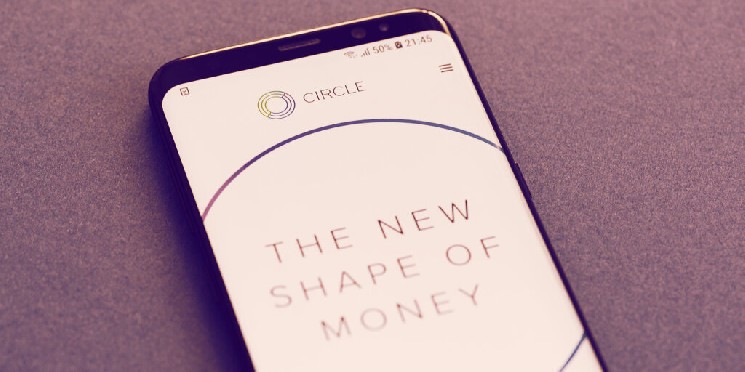Circle Reveals FTX Exposure, Says USDC Conversions on Binance Have Hurt Projections

The collapse of FTX and automatic conversions of USD Coin on Binance will cause Circle’s performance to be “materially lower” than the projections it made in February, the company said in a new regulatory filing.
In it, Circle disclosed that the “tiny” FTX equity that Circle CEO Jeremy Allaire alluded to on Twitter last week is a $10.6 million investment the company made in the FTX Group, according to new regulatory filings.
Relatively speaking, the $10.6 million probably is small for Circle.
5/ Circle is a tiny equity holder of FTX, and FTX is a tiny equity holder of Circle. Circle is also a tiny equity holder of Kraken, Coinbase and BinanceUS.
— Jeremy Allaire (@jerallaire) November 9, 2022
Although the company tends to not disclose how much it has invested in other projects, it has been very active. In just the past couple months, it and its venture capital arm, Circle Ventures, have been part of Ottr Finance’s $3.1 million pre-seed round, Slide’s $12 million raise, and a $150 million round for Aptos.
A Circle spokesperson told Decrypt that while Allaire would have known the amount that Circle invested in FTX, he wouldn’t have wanted to disclose that number in his Twitter thread last week that addressed the “FUD” regarding Circle’s relationship with FTX. “Circle has no material exposure to FTX and Alameda,” Allaire tweeted at the time.
But now, as a result of the FTX Group’s bankruptcy, Circle told its investors that it has stopped all transactions with the company.
“The Company will recognize impairment of its FTX Investments in the reporting period in which impairment indicators arose,” Circle wrote in its amended S-4 filing. “The Company has suspended its services and transactions with the FTX Group and is in process of evaluating the impact on provision of future services to the FTX Group and the potential indirect financial impact of the FTX Group bankruptcy.”
The company originally filed an S-4 with the U.S. Securities and Exchange Commission in August 2021, saying at the time that it planned to go public by combining with Concord Acquisition Corp. at a $4.5 billion valuation. By February, the USD Coin (USDC) stablecoin issuer had doubled its valuation to $9 billion.
The deal was meant to be finalized before the end of the year, Allaire told Fortune in July. But in October, Concord delayed the merger until “no later than January 31, 2023.”
The other—and arguably, bigger—reason Circle may miss the projections it made in February is the ongoing automatic conversions of USDC balances in wallets on crypto exchange Binance to its own Binance USD (BUSD) stablecoin.
For the first half of 2022, Circle reported $84 billion worth of USDC issued by either it or Coinbase—more than double the amount that was issued over the same period in 2021, according to its SEC filing. But that was offset by $71 billion in redemptions, which more than tripled compared to last year. That means the net new $13.5 billion USDC issued through June 30, 2022 shows a decrease of 36% compared to the same period in 2021.
Although Circle acknowledged it’s difficult to know exactly how much USDC has been automatically converted to BUSD, the company told shareholders it has seen “an approximate $3.0 billion increase in BUSD from August 17, 2022 through September 30, 2022 and, accordingly we estimate that up to $3.0 billion of the $8.3 billion decline in USDC in Circulation from June 30, 2022 to September 30, 2022 was driven by the auto conversion by Binance.”
Stablecoin Markets Shift as Binance Begins USDC Conversions
When Binance first announced its plans to automatically convert USDC balances (along with Pax Dollar and TrueUSD) to its own BUSD, the company said it would enhance liquidity for investors.
At the time, Allaire mused that USDC could benefit if USDC became the preferred asset for Binance users to move funds on and off the exchange.
“Given how limited BUSD usage is outside of Binance, this will likely benefit USDC usage as the preferred cross CEX and DEX stablecoin rail,” he wrote on Twitter. “Unless Binance can convince all their competitors to get behind BUSD. Unlikely.”
Sharing some perspective on Binance forced conversion of USDC. Lots of misleading headlines and interpretations. Binance is not ending support for USDC, and change will likely lead to more USDC flowing to Binance. Here’s why. 1/
— Jeremy Allaire (@jerallaire) September 6, 2022
His hypothesis might still prove to be true, but there are currently a lot of market factors working against the stablecoin.
Besides FTX’s collapse and the BUSD conversion, Circle also cited the fact that rising interest rates have caused investors to move their assets out of stablecoins and into “US Treasuries, money market funds and other traditional investment products.”
Those investors haven’t all been from the traditional finance world, either.
MakerDAO is currently the largest decentralized lending protocol, accounting for 15% of the $43.5 billion worth of assets invested in decentralized finance, according to DeFi Llama. Earlier this month, it managed to double its revenue, thanks in part to its decision to invest in U.S. Treasury bonds.
But USDC still makes up the bulk of the lending protocol’s treasury.
On Tuesday afternoon, USDC was still comfortably the second-largest stablecoin with a $44.5 billion market capitalization, according to CoinGecko.
Tether, which saw its market cap reach $71 billion last week, has since experienced a wave of redemptions and now has a market cap of $66 billion. Meanwhile, Binance’s BUSD is the third-largest stablecoin at $23 billion after adding $6 billion to its market cap since Binance began auto-converting USDC, USDP and TUSD balances in early September.






 Bitcoin
Bitcoin  Ethereum
Ethereum  Tether
Tether  USDC
USDC  TRON
TRON  Dogecoin
Dogecoin  Cardano
Cardano  Bitcoin Cash
Bitcoin Cash  Chainlink
Chainlink  Monero
Monero  LEO Token
LEO Token  Zcash
Zcash  Stellar
Stellar  Litecoin
Litecoin  Hedera
Hedera  Dai
Dai  Cronos
Cronos  OKB
OKB  Tether Gold
Tether Gold  Ethereum Classic
Ethereum Classic  KuCoin
KuCoin  Gate
Gate  Algorand
Algorand  Cosmos Hub
Cosmos Hub  VeChain
VeChain  TrueUSD
TrueUSD  Dash
Dash  Tezos
Tezos  Stacks
Stacks  IOTA
IOTA  Basic Attention
Basic Attention  Theta Network
Theta Network  Decred
Decred  NEO
NEO  Synthetix
Synthetix  Qtum
Qtum  Ravencoin
Ravencoin  DigiByte
DigiByte  0x Protocol
0x Protocol  Nano
Nano  Zilliqa
Zilliqa  Holo
Holo  Siacoin
Siacoin  Numeraire
Numeraire  Waves
Waves  Status
Status  BUSD
BUSD  Enjin Coin
Enjin Coin  Pax Dollar
Pax Dollar  Ontology
Ontology  Hive
Hive  Lisk
Lisk  Steem
Steem  Huobi
Huobi  NEM
NEM  OMG Network
OMG Network  Bitcoin Gold
Bitcoin Gold  Augur
Augur  HUSD
HUSD  Ren
Ren